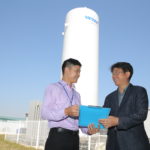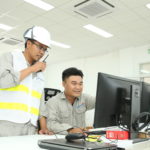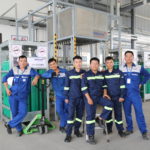With a diversified industrial gases portfolio, Messer expects to meet all of the gas needs of customers.
Xe
Mainly in the atmosphere, with a share of about 0.09 ppm.
The oceans, some rocks, and natural gas sources also contain trace quantities of xenon.
- 111.7 °C
- 108 °C
Colorless, inert like all noble gases, but together with radon the most reactive element of that group. It even reacts directly with fluorine, but most xenon compounds are unstable or occur only under unusual conditions.
Air separation
Xenon is needed for manufacturing processes in the electronics industry and as a propellant for ion thrusters. The noble gas also serves as an inhalation anesthetic.
Noble gases are rare, and that’s especially true of xenon. In fact, it is the rarest stable element on Earth.
In 1895, William Ramsey first isolated helium and recognized that according to the laws of the chemical periodical system, other noble gases also must exist. He did not find xenon, however, until he examined the newly discovered krypton more closely together with Morris William Travers. Through fractionated distillation, they were able to isolate another gas there. Because the discovery had “defied” them so to speak, the two researchers named the substance after the ancient Greek word for foreign or strange: xenos.
Today xenon is extracted from the air in air separation units. Due to the low concentration of xenon in the atmosphere, that process is profitable only in large plants. A special air separation unit that produces 24,000 kilograms of oxygen per hour, for example, would theoretically produce just one kilogram of xenon per day. Today xenon is extracted from liquid oxygen in the air separation process. In an elaborate process in a special air separation unit, it takes 24,000 kilograms of the liquid oxygen to recover about 9.4 kilograms of xenon per day.
Kr
Only 1,14 ppm mass fraction in the Earth’s atmosphere
- 152 °C
- 157.36 °C
Very inert, thermodynamically unstable
Air separation
The noble gas krypton is very difficult to extract from air. Correspondingly expensive, it is primarily used today as a filling gas in double glazed windows, where it provides significantly better insulation than the less expensive argon. Krypton is also used as a filling gas in Geiger counters for measuring radioactive radiation. Other applications take the form of krypton mixtures used in special lasers for performing eye surgery or manufacturing intricate semiconductor components.
The noble gas krypton is one of the rarest elements on Earth. Most of it occurs in the atmosphere. The share of krypton in the universe is greater. Scientists suspect that the interstellar matter whose momentum creates magnetic fields and radiation in interstellar space is rich in krypton.
Krypton played a special role in the definition of the meter: that unit of measure was initially defined by the international prototype meter – a platinum bar, the length of which was one ten-millionth of the distance between the North Pole and the Equator. Through more precise measurement methods, the official length of the meter was altered several times – and its definition was modified likewise.
At the start of the 20th century, the idea of using the wavelength of spectral lines to define the meter emerged. In the early 1950s, scientists developed the krypton-86 discharge lamp, which emitted light with the most stable and reproducible wavelength. Based on that new method, the meter was redefined in 1960. The definition of the meter that is still valid to this day was established in 1983 and is based on a path-time measurement of light in a vacuum.
Ne
- 246 °C
- 248.59 °C
Colorless, odorless gas, extremely inert, low solubility in water, somewhat lighter than air
Air separation
The best known application area for the noble gas neon is the famous neon tubes – even if the present and the future belong to the LED. That’s why neon’s most important application today is excimer lasers, which are mainly used to manufacture semiconductors and display screens. Moreover, neon is used in the form of a mixture in helium-neon lasers – to calibrate spectrometers, for example.
Neon, whose name is based on the ancient Greek word for “new,” was discovered by William Ramsay and Morris William Travers in 1898. The two chemists first heated minerals and parts of meteorites to study the gases generated as a result – but found only the previously known noble gases helium and argon.
It was only later while experimenting with raw argon isolated from liquefied air that they ultimately encountered the as yet unknown neon. In 1910, Georges Claude developed the first practical application of neon – the neon lamp: electric voltage excited the noble gas within its glass body, thereby causing it to emit light.
In the Earth’s atmosphere, neon is relatively rare – its concentration is just 18.2 ppm. It has also been found in granite and basalt as well as in diamonds. Scientists suspect that much of the Earth’s neon has escaped the atmosphere since the creation of the planet. It is one of the most commonly occurring elements in the universe, along with hydrogen, helium, oxygen, carbon and nitrogen.
Do you have questions regarding Messer products, services and technology applications?
We are always ready to support




